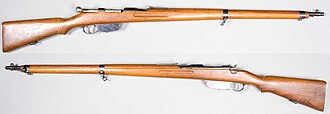Steyr-Mannlicher M1895
| Infanterie Repetier-Gewehr M.95 Gyalogsági Ismétlő Puska M95 (Infantry Repeating-Rifle M95) |
|
|---|---|

Mannlicher M1895 Rifle. From the collections of the Swedish Army Museum.
|
|
| Type | Bolt-action rifle |
| Place of origin | Austria-Hungary |
| Service history | |
| In service | 1895–1945 1895–1918 (Austria-Hungary) |
| Used by | See Users |
| Wars |
Boxer Rebellion First Balkan War Second Balkan War World War I Russian Civil War Austro-Slovene conflict in Carinthia Revolutions and interventions in Hungary Second Italo-Ethiopian War Spanish Civil War Second Sino-Japanese War Sudeten German uprising 1938 World War II |
| Production history | |
| Designer | Ferdinand Mannlicher |
| Designed | 1895 |
| Manufacturer |
1896–1918: Œ.W.G. in Steyr 1897–1918: F.G.GY. in Budapest 1918–1920: Zbrojovka Brno |
| Produced | 1896–1920 |
| No. built | approx. 3,500,000 |
| Variants | See Variants |
| Specifications (M95 Long Rifle) | |
| Weight | 3.78 kilograms (8.3 lb) |
| Length | 1,272 millimetres (50.1 in) |
| Barrel length | 765 millimetres (30.1 in) |
|
|
|
| Cartridge | M95: 8×50mmR Mannlicher M95/30 & 31.M: 8×56mmR M95/24 & M95M: 8×57mm IS |
| Action | Straight-pull bolt action |
| Rate of fire | approx. 30–35 rounds/min |
| Muzzle velocity | M93 (8×50mmR): 620 m/s (2,000 ft/s) M30 (8×56mmR): 720 m/s (2,400 ft/s) |
| Feed system | 5-round en bloc clip (stripper clip in M95/24 and M95M), internal box magazine |
| Sights | Rear V-notch flip-up sight and front post (telescopic sight on sniper variant) |
The Mannlicher M1895 (German: Infanterie Repetier-Gewehr M.95, Hungarian: Gyalogsági Ismétlő Puska M95; "Infantry Repeating-Rifle M95") is a bolt-action rifle, designed by Ferdinand Ritter von Mannlicher that used a refined version of his revolutionary straight-pull action bolt, much like the Mannlicher M1890 carbine. It was nicknamed the Ruck-Zu(rü)ck (German slang for "back and forth") by Austrian troops and "Ta-Pum" by Italian troops who even wrote a song about it during World War I.
The M1895 is unusual in employing a straight-pull bolt action, as opposed to the more common rotating bolt-handle of other rifles. It is consequently renowned for combining a high rate of fire (around 30–35 rounds per minute) with reliability and sturdiness, although this requires decent care and maintenance with an extractor that is vulnerable to breakage due to a lack of primary extraction.
Originally they were chambered for the round-nosed 8×50mmR cartridge, but almost all were rechambered to accept the more powerful spitzer 8×56mmR cartridge in the 1930s.
It was initially adopted and employed by the Austro-Hungarian Army throughout World War I, and retained post-war by both the Austrian and Hungarian armies. The main foreign user was Bulgaria, which, starting in 1903, acquired large numbers and continued using them throughout both Balkan and World Wars. After Austria-Hungary's defeat in World War I, many were given to other Balkan states as war reparations. A number of these rifles also saw use in World War II, particularly by second line, reservist, and partisan units in Romania, Yugoslavia, Italy, and to lesser degree, Germany. Post war many were sold as cheap surplus, with some finding their way to the hands of African guerrillas in the 1970s and many more being exported to the United States as sporting and collectible firearms. The M1895 bolt also served as an almost exact template for the ill-fated Canadian M1905 Ross rifle, though the later M1910 used a complicated interrupted-thread instead of two solid lugs.
...
Wikipedia
